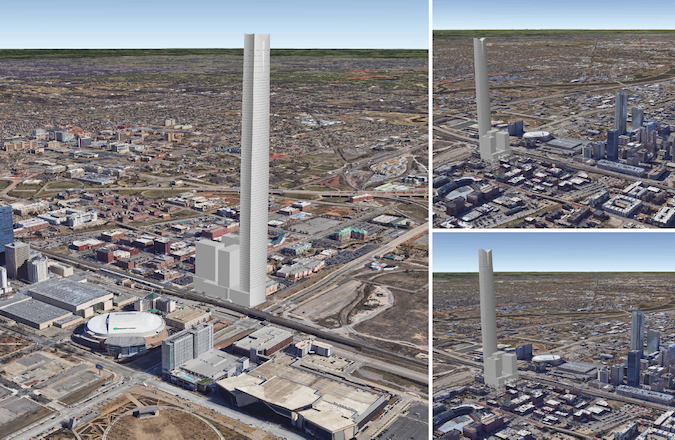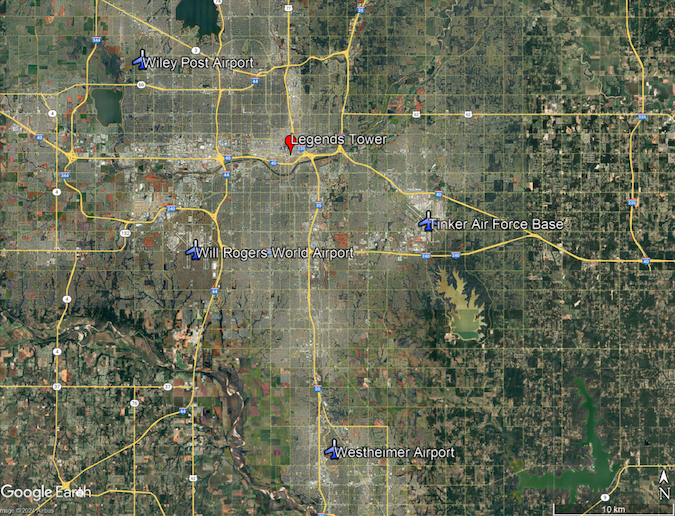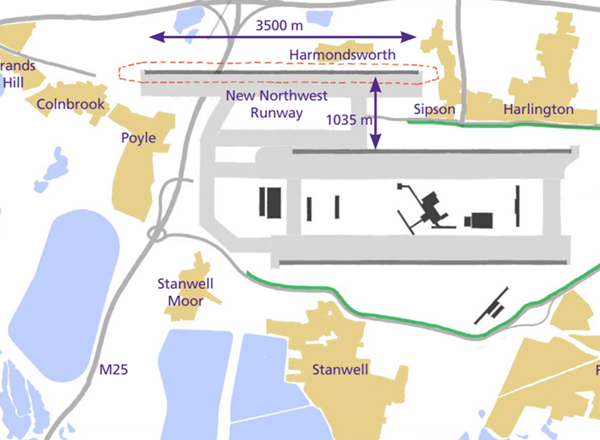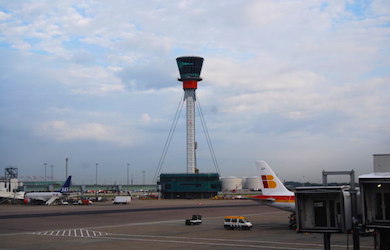The Legends Tower is an approved super tall skyscraper to be located in Oklahoma City, Oklahoma, United States. The 134-story building would stand 581m (1,907ft) tall, making it the sixth largest building in the world and the tallest in the US. The skyscraper in its current height could, however, be at risk due to potential impacts on Instrument Flight Procedures (IFPs).
In this article, we assess the building against the IFPs of surrounding airports to understand the likelihood of the building going ahead in its current form.
The 3D / architecture concept design for the development is shown in Figure 1 below.
Figure 1: 3D / architecture concept design. [1]
Concerns
Airports Director of Oklahoma City, Jeff Mulder, sent a letter to the Federal Aviation Administration (FAA) expressing concerns over the height of the tower and the potential increased travel times, adverse changes to departure schedules, and flight safety issues [2].
He mentions specifically that the tower will increase the Minimum Vectoring Altitude (MVA) over the city, which would change the way aircraft approach the surrounding airports. The MVA is one of many IFPs, which are the procedures used by aircraft solely flying using the instrumentation in the aircraft. For more information on IFPs click – here.
Additional letters sent to the FAA outlined how the tower’s height would complicate and lengthen the time and paths for take-offs and landings [3]. The most notable author was from American Airlines, who told the FAA that the tower’s impact would cause the more than 4,000 flights a year at OKC Will Rogers International Airport to struggle with the ensuing climb restrictions on departures.
This ultimately led Julie Morgan, manager of the FAA’s Obstruction Evaluation Group in Fort Worth, to conclude that if the building is built to 1,907 feet above ground it will be a “hazard to air navigation.” This conclusion was presented in a letter to Scot Matteson, Legends Tower developer, on the 4th December 2024.
Surrounding Airports
The Legends Tower is surrounded by multiple airports which are within ranges where impacts to IFPs are possible. The relevant airports surrounding the development are:
- Will Rogers World Airport (OKC) – approx. 9.5km southwest;
- Tinker Air Force Base – approx. 10.4km southeast;
- Wiley Post Airport – approx. 13.7km northwest;
- Westheimer Airport – approx. 23.2km south.
The locations of these airports relative to the development are shown in Figure 2 below.
Figure 2: Airports surrounding the development.
IFP Assessment
Starting with the MVA, mentioned by Jeff Mulder, this is lowest altitude to which a radar controller may issue aircraft altitude clearances during vectoring/direct routing. In the case of the development, Pager Power’s assessment indicates that it lies within ‘Area K’, which has a current minimum altitude of 3,000ft. This means that the MVA will need to be raised to 4,100ft in order to accommodate the development at its current height. This is indeed the altitude that would be most impacted by the development.
In addition to the MVA, there are additional IFPs that will need to be raised to 4,100ft in order to accommodate the development in its current
- Minimum Sector Altitudes (MSAs):
- MSA IRW currently at 3,100ft (the most restrictive MSA).
- MSA for Wiley Post currently at 3,300ft.
- Other MSAs which are currently at 3,800ft.
- BURSH Terminal Arrival Altitude (TAA) currently 3,800ft.
There are also predicted to be impacts to specific departure / approach procedures, which will need to be diverted to accommodate the development. Diverting specific IFPs is a complex process completed by specialised organisations and is therefore not mentioned further in this article.
What’s Next?
If the relevant altitudes cannot be raised and the relevant procedures cannot be changed, the final height of the building may need to be decreased. Based on the calculations undertaken in this article, a decrease to 247m (810ft) above ground would remove any requirement of an airspace change.
The developer is yet to confirm whether it plans on decreasing the height of the tower; however, it is likely that a reduction of over 300m would not be welcomed. It is expected that the developer will need to engage with the FAA to determine what airspace / procedure changes can be accommodated and the implications on the final building height.
Pager Power will be sure to keep a close eye on how the project develops to ensure that it can safely coexist with the surrounding airports.
Pager Power
Within the design of IFPs, rules are set out regarding obstacle clearance, to ensure the necessary safeguarding of these procedures. IFPs are one of the most complicated elements to consider when wanting to build a structure near an aerodrome, as one has to consider where the obstacle is in relation to multiple stages of multiple flight paths for multiple types of aircraft.
Pager Power is able to undertake IFP assessments for developers alongside other physical safeguarding assessments at the early stages of a project. These assessments can help identify any adversely affected IFPs and recommend allowable heights in order to avoid these impacts. There should therefore be no surprises when commissioning an official assessment by the airport’s licensed IFP assessor at the planning stage.
References
[1] AO Architects (2023). The Boardwalk of Bricktown. [online] KFOR. Available at: https://kfor.com/wp-content/uploads/sites/3/2023/12/Boardwalk-at-Bricktown.pdf [Accessed 16 Dec. 2024].
[2] Eberhardt, E. (2024). Aviation authority concerns delay US tallest skyscraper plans. [online] Dezeen. Available at: https://www.dezeen.com/2024/12/09/aviation-authority-concerns-legends-tower-oklahoma-city/ [Accessed 16 Dec. 2024].
[3] Lackmeyer, S. (2024). Proposed record-breaking skyscraper for Bricktown a ‘hazard’ to air travel, FAA says. [online] The Oklahoman. Available at: https://eu.oklahoman.com/story/business/downtown/2024/12/11/legends-tower-okc-skyscraper-faa-report-hazard-air-travel/76915395007/ [Accessed 16 Dec. 2024].





